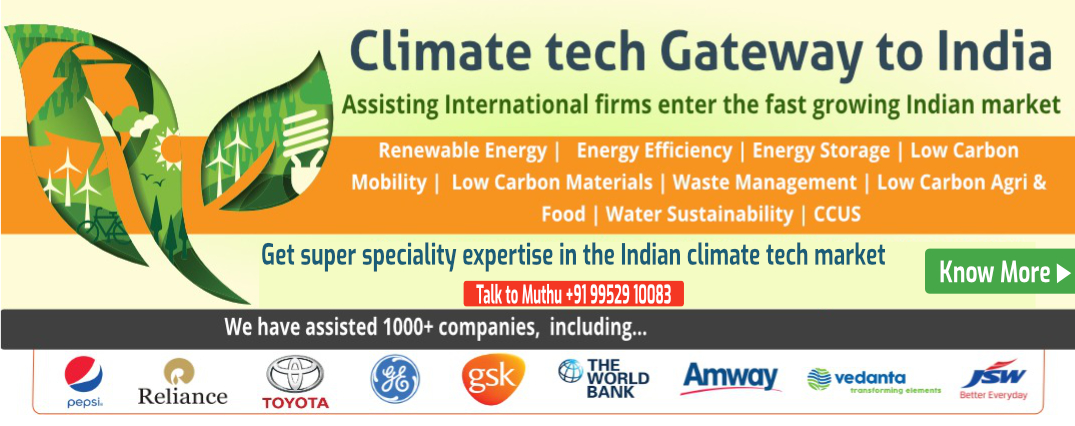This post is a part of Climate G2I Intelligence series from Energy Alternatives India (EAI), India’s leading climate-tech consulting firm.
G2I stands for Gateway 2 India, and provides comprehensive market intelligence and go-to market assistance for International firms entering the Indian climate-tech market. More about Climate G2I from here
Thermax, an Indian energy and environment engineering company, and Fortescue Future Industries (FFI), an Australian green energy company, have recently inked a Memorandum of Understanding (MoU) aimed at exploring green hydrogen projects in India. This collaboration seeks to combine FFI’s expertise in green hydrogen production with Thermax’s established engineering and project management capabilities within the Indian market. The goal is to develop integrated green hydrogen solutions for commercial and industrial clients across the country, contributing to India’s ambitious clean energy transition.
This partnership emerges within India’s rapidly evolving green hydrogen sector. India has set bold targets for the adoption of green hydrogen to decarbonize industries like steel, cement, and chemicals. The Indian market presents an exceptional opportunity, characterized by substantial energy transition needs, a growing startup ecosystem dedicated to climate tech, and strong governmental support through incentives and policies.
The pathway toward widespread green hydrogen adoption in India promises to attract even more players and strategic collaborations. Partnerships like the Thermax-FFI initiative are joining forces with broader alliances like the India Hydrogen Alliance (IH2A) and global initiatives like the Green Hydrogen Catapult to accelerate the development of a thriving green hydrogen ecosystem. This drive includes establishing manufacturing capacity, facilitating technological innovation, and fostering supportive regulatory frameworks.
Net Zero by Narsi
Insights and interactions on climate action by Narasimhan Santhanam, Director - EAI
View full playlistHowever, navigating this dynamic landscape also presents challenges. The green hydrogen sector in India still faces obstacles like the need for cost reduction in production, the development of robust infrastructure, gaps in workforce skills, and the need for further standardization. Additionally, the current limited domestic manufacturing capabilities mean there’s a need to increase the extent of indigenization within the industry. The Indian government’s National Green Hydrogen Mission is addressing this with targeted initiatives, but progress will require sustained effort from both the public and private sectors.
The Thermax-FFI collaboration isn’t alone in forging a path toward a green hydrogen future in India. Several other noteworthy initiatives are contributing to this burgeoning sector. The Greenko and Uniper, a German-Indian partnership involves Greenko, a leading Indian renewable energy company, supplying 250,000 tonnes of green ammonia annually to Uniper, a German gas and electricity trading company. This collaboration highlights the potential of green hydrogen derivatives like ammonia in clean energy solutions.
Furthermore, India and Saudi Arabia’s collaboration goes beyond green hydrogen, aiming to establish a comprehensive framework for electrical interconnections and co-production of green hydrogen. This highlights India’s strategic efforts to secure partnerships and resources for its clean energy transition.
These partnerships showcase the diverse forms collaboration can take in the Indian green hydrogen sector, fostering knowledge sharing, market access, and technological advancements, ultimately propelling India towards becoming a key player in the global green hydrogen revolution.
Overall, the Thermax-FFI collaboration signifies a promising step within India’s burgeoning green hydrogen landscape. Alongside supportive government policies, a growing network of strategic partnerships, and a commitment to overcoming existing challenges, India is poised to emerge as a key player in the global green hydrogen revolution.
This post is a part of Climate G2I Intelligence series from Energy Alternatives India (EAI), India’s leading climate-tech consulting firm.
G2I stands for Gateway 2 India, and provides comprehensive market intelligence and go-to market assistance for International firms entering the Indian climate-tech market. More about Climate G2I from here





 Our specialty focus areas include
Our specialty focus areas include



